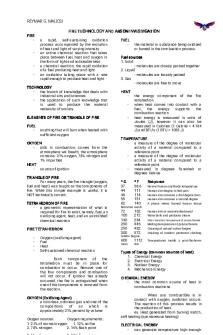Burglary, Trespass, Arson, and Mischief PDF

| Title | Burglary, Trespass, Arson, and Mischief |
|---|---|
| Author | Rebecka Bahn |
| Course | Principles Of Criminal Law |
| Institution | Southern Illinois University Edwardsville |
| Pages | 2 |
| File Size | 74.2 KB |
| File Type | |
| Total Downloads | 1 |
| Total Views | 160 |
Summary
notes about Burglary, Trespass, Arson, and Mischief ...
Description
Burglary, Trespass, Arson, and Mischief Burglary ● Elements of burglary at the common law include: ○ Breaking: altering of the structure in order to gain entry ○ Entry: the entry must be trespassing and by the means of the breaking ■ Any portion of the body is considered entry ○ Dwelling House: look at all buildings in property ○ Nighttime: had to occur at night, central element ■ Not on exam, not in current law ● Mens Rea- difference between burglary and trespassing ○ The common law required that individuals possess an intent to commit a felony within the dwelling at the time that they enter the building ■ Carrying a weapon ● Case ○ Bruce v. Commonwealth- LANDMARK ■ Issue: Did the appellant break into the trailer? ● Came in front door (unlocked), exited out the back door, came back in the back door with a gun ■ Holding: A breaking from within in order to facilitate an entry for the purpose of committing a crime is sufficient to prove the breaking element ● Guilty ○ Hitt v. Commonwealth ■ Issue: Was Hitt’s breaking and entry into the bedroom a burglary? ● Man inside house forces way into locked bedroom in home ■ Holding: conviction reversed Trespass ● Unauthorized entry or remaining on the land or premises of another ● Defiant trespass: remaining on the property after have been given clear notice to leave ● Computer trespass: intentionally and without authorization accessing a computer, a computer system, or network, with the intent to delete, damage, destroy or disrupt the computer, computer system, or network ● Mens Rea ○ State statutes differ on the mens rea ■ Knowingly, purpose, strict liability ○ Illinois: mens rea = knowingly ● Case ○ State v. Chatelain ■ Issue: Should Chatelain be held criminally liable for a burglary or a trespass? ● Entered premise to smoke and ■ Holding: held criminally responsible for trespass
Arson ● Common law arson is defined as the willful and malicious burning of the dwelling house of another ● Requirements: ○ Burning: the consuming of the material of the house or the alteration by fire of the house ○ Dwelling house: home and all buildings on property ● Mens Rea ○ The mens rea of common law of arson is malice (purposeful, knowing, or reckless) ● Case ○ Williams v. State ■ Issue: Does smoke and soot damage constitute an arson? ● Fire caused damage in house ■ Holding: smoke and soot damage are arson = guilty Criminal Mischief ● The common law misdemeanor of malicious mischief is defined as the destruction of, or damage to the personal property of another ○ Has to be tangible property ○ Examples: writing on someone’s car, forking, teepee a house, any type of vandalism ● Actus Reus ○ Destruction or damage to real tangible property ○ Tampering with tangible property so as to endanger a person or property ○ Deception or threat causing a financial loss ● Mens Rea ○ Acts should be committed purposely or recklessly ● Case ○ People v. Nicholas Y. ■ Issue: Did Nicholas Y. vandalize the property? ● Man vandalizes movie screen ■ Holding: conviction affirmed...
Similar Free PDFs

Theft and burglary - coursework
- 6 Pages

Literal rule and mischief rule
- 9 Pages

The Mischief Rule-Q9
- 1 Pages

Burglary - Definition
- 2 Pages

Criminal Damage and Arson Notes
- 3 Pages

Trespass Doc - ---
- 14 Pages

Legal Memo on Arson
- 13 Pages

Trespass Notes
- 23 Pages

Trespass to land - Notes
- 7 Pages

LAWS 1203 - Trespass Summary
- 7 Pages

Burglary 1st year
- 7 Pages

The Mischief Rule
- 2 Pages
Popular Institutions
- Tinajero National High School - Annex
- Politeknik Caltex Riau
- Yokohama City University
- SGT University
- University of Al-Qadisiyah
- Divine Word College of Vigan
- Techniek College Rotterdam
- Universidade de Santiago
- Universiti Teknologi MARA Cawangan Johor Kampus Pasir Gudang
- Poltekkes Kemenkes Yogyakarta
- Baguio City National High School
- Colegio san marcos
- preparatoria uno
- Centro de Bachillerato Tecnológico Industrial y de Servicios No. 107
- Dalian Maritime University
- Quang Trung Secondary School
- Colegio Tecnológico en Informática
- Corporación Regional de Educación Superior
- Grupo CEDVA
- Dar Al Uloom University
- Centro de Estudios Preuniversitarios de la Universidad Nacional de Ingeniería
- 上智大学
- Aakash International School, Nuna Majara
- San Felipe Neri Catholic School
- Kang Chiao International School - New Taipei City
- Misamis Occidental National High School
- Institución Educativa Escuela Normal Juan Ladrilleros
- Kolehiyo ng Pantukan
- Batanes State College
- Instituto Continental
- Sekolah Menengah Kejuruan Kesehatan Kaltara (Tarakan)
- Colegio de La Inmaculada Concepcion - Cebu



